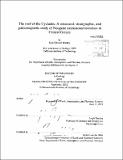The roof of the cyclades : a structural, stratigraphic, and paleomagnetic study of Neogene extensional tectonics in Central Greece
Author(s)
Bradley, Kyle Edward
DownloadFull printable version (29.51Mb)
Alternative title
Structural, stratigraphic, and paleomagnetic study of Neogene extensional tectonics in Central Greece
Other Contributors
Massachusetts Institute of Technology. Department of Earth, Atmospheric, and Planetary Sciences.
Advisor
Leigh Royden.
Terms of use
Metadata
Show full item recordAbstract
In this thesis use a variety of geological observations to address the record of Neogene crustal deformation in the Central Aegean region, thereby providing new constraints on the overall geometric and tectonic evolution of an extensional system that is largely governed by the dynamics of a retreating subducting slab. I document a newly-described low-angle normal fault, termed the Octonii Detachment, that accommodated NE-SW directed crustal extension and controlled the pattern of sedimentation within the Early to Middle Miocene Kymi-Aliveri basin. I date the basin fill using a combination of magnetostratigraphy and U/Pb zircon geochronometry. Through detailed mapping of the spatial variation in sedimentary facies within the basin, I relate the record of sedimentation to Middle Miocene extensional exhumation of the metamorphic core complexes exposed in the Cycladic archipelago. In contrast with models of supra-detachment basin development related to fragmentation of the upper plate by arrays of parallel normal faults, I deduce that sedimentation in the Kymi-Aliveri basin occurred in the synformal core of a large-scale, extension-parallel fold. These observations provide direct upper-plate constraints on the timing and kinematics of crustal extension in a region that has been dominated by observations of lower-plate metamorphic rocks. Through paleomagnetic measurement of vertical-axis rotations in Early Miocene through Pliocene basin sequences and associated volcanic rocks, I constrain the initiation of rapid clockwise rotation in Central Greece to post-Early Pliocene time, and infer that Central Greece underwent two pulses of very rapid clockwise rotation separated by a ~10 million year interval of no apparent rotation. This paroxysmal style of deformation contrasts strongly with previous models of long-term, slow rotation driven by gradual trench retreat. I propose a model for the Pliocene deformation of the External Hellenides based on published paleomagnetic data that invokes lateral segmentation of the thrust belt along spaced zones of right-lateral deflection without development of through-going faults at the surface. This analysis attempts to explain how right-lateral motion of an internally stable Aegean Sea block was accommodated between the Kephalonia transform fault and the western prolongation of the North Anatolian Fault. Finally, I use paleomagnetic measurements from a ~3.4 billion year old volcanic and sedimentary succession preserved in the East Pilbara terrane in Western Australia to show that Earth's climate and geomagnetic field geometry could have arisen in a modern form by this time, and that the two oldest well-preserved rock sequences on Earth could in fact be remnants of a single terrane.
Description
Thesis (Ph. D. in Geology)--Massachusetts Institute of Technology, Dept. of Earth, Atmospheric, and Planetary Sciences, 2012. "September 2012." Cataloged from PDF version of thesis. Includes bibliographical references.
Date issued
2012Department
Massachusetts Institute of Technology. Department of Earth, Atmospheric, and Planetary SciencesPublisher
Massachusetts Institute of Technology
Keywords
Earth, Atmospheric, and Planetary Sciences.